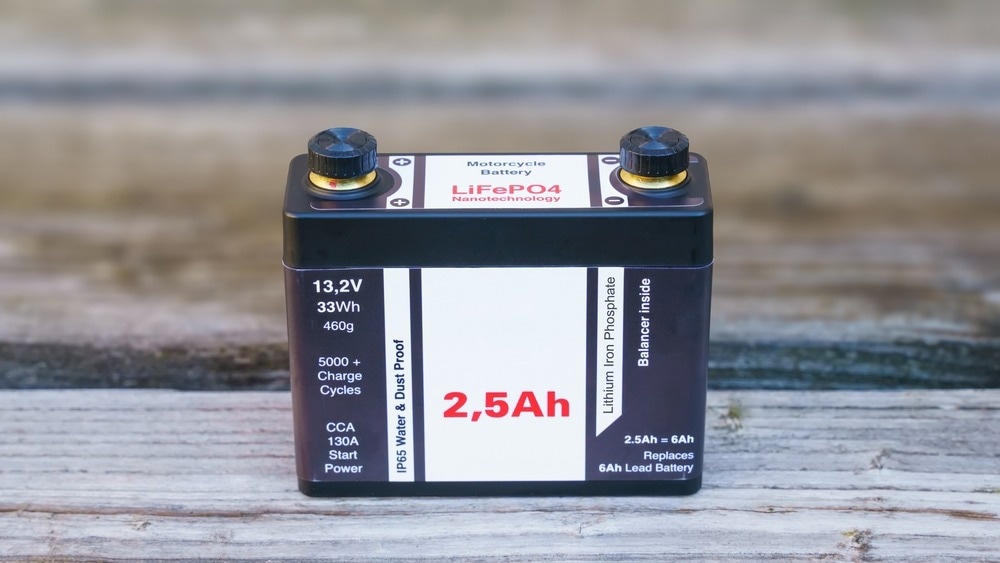The battery technology field is being led by lithium iron phosphate (LiFePO4) batteries. The batteries do not contain the toxin cobalt and are more affordable than the majority of their alternatives. They are non-toxic and have a longer shelf life. The LiFePO4 battery has excellent potential for the foreseeable future.

Image Credit: Sahara Prince/Shutterstock.com
Lithium Iron Phosphate Batteries: Highly Efficient and Renewable Choice
A LiFePO4 battery can achieve maximum charge in less than two hours of charging and when the battery is not being used, the rate of self-discharge is just 2% per month, whereas the rate for lead-acid batteries is 30%.
When compared with lead-acid batteries, lithium-ion polymer (LFP) batteries offer an energy density that is four times greater. These batteries also have their full 100% capacity available and can be charged in a short amount of time as a result. Because of these variables, the electrochemical performance of LiFePO4 batteries is very efficient.
The battery energy storage devices may help companies to reduce their electricity expenses. The battery systems store extra renewable energy for use at a later time when the company needs it. In the absence of an energy storage system, companies are compelled to purchase energy from the grid rather than using their own previously created resources.
The battery has consistent power with the same amount of current even when the battery is at 50% capacity. LFP batteries, unlike their competitors, can work at high temperatures. The robust crystal structure of iron phosphate will also not break down when charging and discharging, leading to its cycle endurance and extended lifespan.
Multiple variables contribute to the improvement of LiFePO4 batteries, including their low weight. They are about 50 percent lighter than other lithium batteries and approximately 70 percent lighter than lead batteries. Using a LiFePO4 battery in a car results in reduced gas consumption and enhanced maneuverability.
An Environment-Friendly Battery
When compared with lead-acid batteries, LiFePO4 batteries represent a far lower threat to the surrounding environment since the electrodes in these batteries are constructed from non-hazardous materials. Every year, the number of lead-acid batteries that are thrown away exceeds three million tons.
The material utilized in the electrodes, wires, and casings of LiFePO4 batteries may be retrieved by recycling these batteries. New lithium batteries could benefit from the incorporation of some of this substance. This specific lithium chemistry is perfect for high-power purposes and energy projects such as solar energy installations since it can withstand very high temperatures.
Consumers have the option of purchasing LiFePO4 batteries created from recycled materials. Because lithium batteries used for energy transportation and storage have such a long lifespan, a significant number of them are still in use, despite the fact that recycling procedures are still in development.
Broad Array of LiFePO4 Applications
These batteries are brought to use in a wide variety of settings, including solar panels, automobiles, boats, and other applications.
LiFePO4 is the safest and most durable lithium battery available for commercial usage. Therefore, they are ideal for industrial applications such as floor machines and liftgates.
LiFePO4 technology can be used in a broad range of applications. Having a longer runtime and a shorter charge time means extra time fishing in kayaks and fishing boats.
New Research of Ultrasonic Approach on Lithium Iron Phosphate Batteries
The quantity of used lithium iron phosphate batteries is growing on an annual basis; if these batteries are not disposed of in a reasonable timeframe, they will contribute to environmental pollution and consume a significant amount of metal resources.
The cathode of lithium iron phosphate batteries contains a significant quantity of the metals that make up their makeup. The ultrasonic approach is an important step in the whole process of recovering discharged LiFePO4 batteries.
To solve the inefficiencies of the LiFePO4 recycling technique, the airborne bubble dynamic mechanism of ultrasonic in the elimination of lithium phosphate cathode materials was explored using high-speed photography and Fluent modeling, as well as the disengagement process.
The lithium iron phosphate recovery efficiency reached 77.7 percent, and the recovered LiFePO4 powder exhibited excellent electrochemical characteristics. The innovative disengagement procedure developed in this work was used to recover waste LiFePO4.
New Advancement of Lithium Iron Phosphate
LiFePO4 batteries can be recharged, making them an asset to our environment. The use of batteries as a means of storing renewable energy is effective, dependable, safe, and beneficial for the environment. Further advancement of new lithium iron phosphate materials may be generated using the ultrasonic process.
Read more: The World's First Fully Renewable Lithium-Ion Battery
References and Further Reading
Zhou, M., et al. (2022) Recovery of Lithium Iron Phosphate by Specific Ultrasonic Cavitation Parameters. Sustainability. https://doi.org/10.3390/su14063390
Disclaimer: The views expressed here are those of the author expressed in their private capacity and do not necessarily represent the views of AZoM.com Limited T/A AZoNetwork the owner and operator of this website. This disclaimer forms part of the Terms and conditions of use of this website.